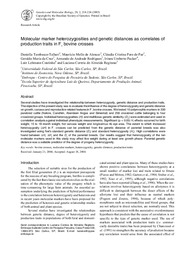Molecular marker heterozygosities and genetic distances as correlates of production traits in F1 bovine crosses.
Molecular marker heterozygosities and genetic distances as correlates of production traits in F1 bovine crosses.
Summary: Several studies have investigated the relationship between heterozygosity, genetic distance and production traits. The objective of the present study was to evaluate the influence of the degree of heterozygosity and genetic distance on growth, carcass and reproductive related features in F1 bovine crosses. We tested 10 polymorphic markers in 330 purebred cattle (Nelore, Canchim, Aberdeen Angus and Simental) and 256 crossbred cattle belonging to four crossbred groups. Individual heterozygosities (Hi) and multilocus genetic similarity (Dm) were estimated and used in correlation analysis against individual phenotypic measurements. Significant (p < 0.05) Hi effects occurred for birth weight, 15 to 18 month weight, hot carcass weight and longissimus rib eye area. The extent to which increased heterozygosity (deltaH) in F1 crosses can be predicted from the genetic distance of parental breeds was also investigated using Nei's standard genetic distance (Ds) and standard heterozygosity (Hs). High correlations were found between deltaHi, deltaHs and the Ds of the parental breeds. Our results suggest that heterozygosity of the ten molecular markers used in this study may affect live weight during at least one growth phase. Parental genetic distance was a suitable predictor of the degree of progeny heterozygosity.
Publication year: 2005
Types of publication: Journal article
Observation
Some of Embrapa's publications are published as ePub files. To read them, use or download one of the following free software options to your computer or mobile device. Android: Google Play Books; IOS: iBooks; Windows and Linux: Calibre.
Access other publications
Access the Agricultural Research Database (BDPA) to consult Embrapa's full library collection and records.
Visit Embrapa Bookstore to purchase books and other publications sold by Embrapa.

